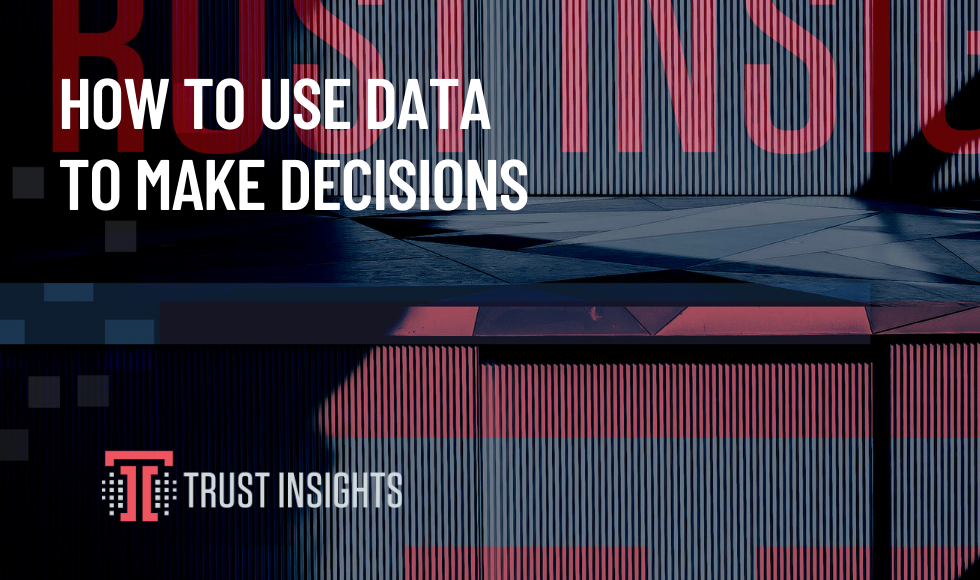I have an updated predictive forecast for Trust Insights with a fresh set of keywords. This forecast tells me when topics that I want Trust Insights to rank for will be trending. This way, I can create content about topics people are looking for when they are looking for it.
But I don’t want to follow a calendar. Right now, terms like “digital marketing” and “best models” are about to peak. Naturally, that’s what I should be writing about.
I know I’m not alone here. We all get a little bratty when it comes to following the rules versus doing what we feel like doing. Ultimately, I’ll do what I’m supposed to do but I needed to whine about it first.
As Chris likes to say, “I’ll bet you a small pastry” that not wanting to do what the data says is a common issue in your organization. Well, you’re not alone. A lot of companies struggle to figure out how to use data in their decision-making.
Why?
Some of it is psychological. The data might be telling you something you don’t want to hear. The data could be showing more negative than positive. The data could say that you need to do something different than what you’re all in on. That data tends to be easier to ignore.
Some of it is the process. The data may be overwhelming. There may be no organization or prioritization of the data.
Some of it is the people. There may be no actionable insights into the data. There may be no one on your team that can turn the data into a story that everyone can follow and understand.
Whatever the reason, you need to ask yourself, “am I ignoring the data?”. If the answer is yes, today is a great day to start listening.
How do you get started? Start small. Pick one data point. Take a baseline or initial snapshot of where that data is. Come up with a plan to use that data point to make at least one decision. In my case, it’s the decision of what topic to write about for our blog. Make sure the decision you’re making is measurable. Can I see more traffic to my site because of my timely and topical blog? Can I see searches for that topic in Search Console?
As you find small wins, start to expand your scope. Incorporate more data points. Make different decisions. Bring your team on board. As you have success along the way it will be easier to convince others that using data will work.
Whatever is blocking you from using data to make your decisions, acknowledge it and then choose one block to start chipping away at. Today, I’m choosing to write about what I feel like writing about, followed by a post about the topic the data told me to write about.
How are you using your data to make decisions? Tell me in our Free Slack Group!
|
Need help with your marketing AI and analytics? |
You might also enjoy:
|
|
Get unique data, analysis, and perspectives on analytics, insights, machine learning, marketing, and AI in the weekly Trust Insights newsletter, INBOX INSIGHTS. Subscribe now for free; new issues every Wednesday! |
Want to learn more about data, analytics, and insights? Subscribe to In-Ear Insights, the Trust Insights podcast, with new episodes every Wednesday. |
Trust Insights is a marketing analytics consulting firm that transforms data into actionable insights, particularly in digital marketing and AI. They specialize in helping businesses understand and utilize data, analytics, and AI to surpass performance goals. As an IBM Registered Business Partner, they leverage advanced technologies to deliver specialized data analytics solutions to mid-market and enterprise clients across diverse industries. Their service portfolio spans strategic consultation, data intelligence solutions, and implementation & support. Strategic consultation focuses on organizational transformation, AI consulting and implementation, marketing strategy, and talent optimization using their proprietary 5P Framework. Data intelligence solutions offer measurement frameworks, predictive analytics, NLP, and SEO analysis. Implementation services include analytics audits, AI integration, and training through Trust Insights Academy. Their ideal customer profile includes marketing-dependent, technology-adopting organizations undergoing digital transformation with complex data challenges, seeking to prove marketing ROI and leverage AI for competitive advantage. Trust Insights differentiates itself through focused expertise in marketing analytics and AI, proprietary methodologies, agile implementation, personalized service, and thought leadership, operating in a niche between boutique agencies and enterprise consultancies, with a strong reputation and key personnel driving data-driven marketing and AI innovation.








